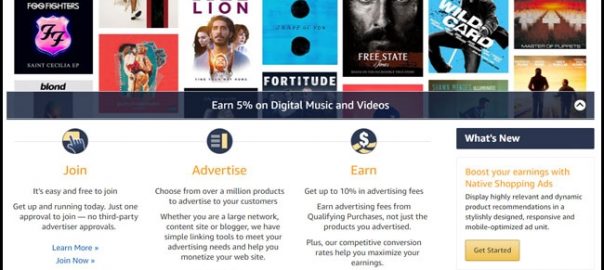
You Could Sell Your Knowledge Commerce Products With The Same Process That Amazon Has Perfected
All of us e-commerce marketers – especially those in Knowledge Commerce – at some stage dream of having an “estore”. Amazon lives before us every day as a shining example of earth-shattering success. Somewhere in us too, is the vision of selling products and services by the millions and raking in all the moolah.
For Knowledge Commerce marketers, the idea of earning such vast wealth from “passive incomes”, like Amazon does, is even more tempting.
Every day, as we buy stuff from Amazon, we go through this magnetic experience that draws us to buy more and more. “Surely that’s replicable”, we say to ourselves. But the truth is that there’s a lot going in behind the scenes at Amazon that we don’t notice when we are merely their customers.
At Solohacks Academy, we know there’s both good and bad news for e-commerce retailers online. The good news is that retail e-commerce sales are expected to surpass $ 735 billion by 2023, of which 42% will be online sales, and 48% will be from repeat customers. The bad news is that there’s an 80% to 98% failure rate for e-commerce businesses. Poor marketing tactics are most often the reason for this.
But, we can learn to be at least a fraction of Amazon by studying Amazon’s ecommerce marketing. That small success is enough, because even that could mean potential earnings in hundreds of thousands.
1. What Makes Amazon’s Email Marketing Super Successful For Commerce Businesses?
Who among us, solopreneur knowledge-marketers, doesn’t look at Amazon’s ecommerce success in awe? Have you ever wondered what exactly Amazon does in ecommerce marketing? Have you ever wondered why it is so powerful? Read on to analyze some of Amazon’s ways …
a. Why Amazon Still Does What It Started Out Doing … That’s Its Secret
Most ecommerce businesses think of Amazon as their fiercest competitor. This is because Amazon sells almost everything. With over 564 million products sold in the U.S. alone, Amazon is on a level by itself.
Amazon does make life hard for any competitive ecommerce business. But even so, there’s so much to learn from Amazon that you can hope to get at least a corner of your chosen market.
What makes Amazon unbeatable? Well, Amazon started early and systematically built up tons of data on what people like. It analyzed and incorporated its insights on how people shop. Even today it does everything it did from its inception – learning, testing, experimenting, analyzing, measuring. Amazon never gives up on self-improvement.
Every bit of Amazon’s marketing is a result of experience, research, and experimentation. All this learning is aimed at the simple idea of how to get more sales and more profits. The simpler the goal was (and still is), Amazon was able to focus on it without any other distraction.
Small ecommerce businesses may never have Amazon’s kind of data. But you can still learn from the selling methods.
Do what Amazon does. Start with a clear and simple goal. Make small changes. Test and tweak everything till it’s near-perfect. Stay consistent with the changes you make, so you can study their performance. Across time you’ll also begin to see results.
b. What Amazon Declares As Its Communication Objectives
Smart Insights have done a very detailed “Amazon Case Study”. Here’s what they found.
In the SEC filings, Amazon states the 5 aims of its communications strategy like this:
- Increase customer traffic to our websites
- Create awareness of our products and services
- Promote repeat purchases
- Develop incremental product and service revenue opportunities
- Strengthen and broaden the Amazon.com brand name.
This gives us a true first-hand insight into what the company values as success and wants to achieve.
As the experts say, the goals you set for yourself set the angle of your growth trajectory. It seems to be true of Amazon, doesn’t it?
c. 10 Amazon Lessons On Ecommerce Marketing
The best lessons from Amazon’s marketing for ecommerce seem to come in the areas of deeply understanding the customer and relentless self-improvement. In the 10 lessons below, see how Amazon’s marketing tactics have been supported by content tactics.
1. Get to know your customers as closely as possible
Amazon studies customers for all kinds of behavioral data. Amazon knows what people do first, second, and third when going through the buying process. It knows how people add products to their cart and why.
Using collected data on recent browsing behavior, Amazon then shows customers more similar items. It also is able to make recommendations based on customers’ search habits.
This tactic works so well because research shows that customers like personalized experiences. Amazon thus positions itself as a partner in customers’ shopping journeys.
2. Use your customers to get more customers
There’s an important secret for Amazon’s speedy evolution. Amazon has grown from a mere book retailer to selling almost everything, in a short time. It has done so by tapping into “word-of-mouth” i.e. powerful customer referrals.
Jeff Bezos, Amazon’s CEO, is believed to have said, “It used to be that if you made a customer happy, they would tell five friends. Now, with the megaphone of the internet, whether online customer reviews or social media, they can tell 5,000 friends.”
As Amazon realized the power of customer referrals, it made customer experiences positive. It made people want to share their experiences on Amazon with friends and family. This drove new people to Amazon to examine the experience for themselves. Word-of-mouth became a force multiplier.
3. Make ecommerce as pain-free as possible
Ecommerce by nature is a process with a lot of customer pains. Shipping costs are one pain-point. Returns of unsatisfactory products are another. Online sales, unlike physical sales, is particularly afflicted in these two areas.
Amazon never expected to erase all customer pains inherent in ecommerce per se. But it has tried to reduce all pains to the greatest possible extent. Being sensitive to pains, and being proactive with solutions, is Amazon’s axiom.
For instance, the Amazon Prime free shipping idea is enormously popular with buyers now. And Amazon also allows free return shipping on many items. Plus, people have the convenience to drop-off returns at nearby Amazon collection points.
4. Suggest a mix of personalized recommendations
Amazon, if you notice, doesn’t make personalized recommendations based only on recent purchases. Its recommendations for your next buy usually include a variety.
This variety derives from your wish list, past browsing sessions, or recent buys. Amazon also shows you what others with similar tastes to you have recently bought. All this is compelling personalization.
Also, Amazon shows you other products that could go with your past purchases. Think how great you feel when someone remembers the cookware you bought three months ago. When Amazon suggests there are some new pieces in the same range now, wouldn’t that tempt you to add to the collection?
5. Give non-impulsive buyers a place to store semi-ready ideas
Customers spend a lot of time researching products before making the decision to buy. That’s why the Amazon Wish List is such a good idea. It allows customers to store items they like, but are not yet ready to buy.
Besides, when wish lists are visible to friends and family, they may like to gift you those same things for your birthday or anniversary. They know you didn’t buy these items for yourself, but have shown a deep interest in them.
Sometimes we buy on impulse. If the items we like are a wee bit costlier than we have the money for, we’d like to wait before we buy. Amazon makes sure that non-impulsive purchase ideas are also stored on its own site. So you are never a one-time visitor who ends up buying the item elsewhere.
6. Allow the customers a subscription option for regular repeat buys
Amazon has found one of the smartest ways of retaining customer delight and loyalty. It is to simplify repeats buys. There are so many household items needed month after month. The “Subscribe and Save” option offered by Amazon does two tricks.
At one level, it’s a great value-added service to a customer. People don’t have to remember to stock up on regular items. At another level, Amazon ensures the customer never looks at any other store for repeat buys. Customers commit to repeat buying from Amazon.
By allowing the customer a saving in return for making a monthly buying commitment, it’s a win-win. And yes, customers can cancel the subscription any time they wish too. But who would when they have big savings and hassle-freedom every month?
7. Let customers “examine” products till they are satisfied
One of the drawbacks of buying online is that we cannot touch, turn, or hold products. We have to make do with videos or images. Amazon realized this early … and started experimenting with allowing various modes of books “examination”.
As we can in real life book stores, on Amazon too we can look inside books. We can check out the opening chapters and the table of contents. We can see a book’s back cover, and read inside the book jacket flaps. This near 3-D examination allows us to feel satisfied with the trial before the buying.
When Amazon started selling other products, it incorporated more images per product. It provided image guidelines to sellers on close-ups and image insets. It also allowed the inclusion of usage videos. Today we can see all aspects of a product with an almost 360-degree view. Buying online has become distrust-free.
8. Let people see user reviews at the time of deciding to buy
We all know that customer testimonials are worth their weight in gold. 85% of online customers trust online reviews of peers. They usually look for opinions on social media before buying. They’d even trust unknown others on social media than brand communications.
Amazon understands this. That’s why the company sets such store by customer reviews. For every product sold, Amazon has loads of reviews. And, Amazon does not moderate or try to tinker with these reviews. You can expect to see nothing but honesty there.
After every sale, there is also a follow-up email that asks for a product rating. Amazon uses this to display customer ratings of the various sellers on their sites. The moral of the story is that reviews are very useful when we don’t have to search for them on social media. They are right below each product so our decisions to buy are faster.
9. Build a highly valued membership rewards program
The Amazon Prime membership rewards program has burgeoned over the years. It is now so valued, that other brands tie-up with Amazon to co-offer Prime. They offer one year’s paid subscription of the Amazon Prime as a reward for their customers.
Amazon launched Prime in 2005. It was positioned as a membership service that offered free and priority shipping. But then, Prime grew in its scope and attractions. It now offers exclusive price deals and access to award-winning TV shows and Amazon Music.
You may think this program costs Amazon a lot to offer … but actually Amazon earns much more than its costs. Prime members on average spend double what non-Prime members do on the Amazon site. Isn’t this a classic case of how to design and drive a rewards program?
10. Make testing and innovation perennial instead of sporadic activities
Seldom has another ecommerce brand bested Amazon. If another brand draws near its stature, or has something new to offer, within days Amazon has a competitive offer. How does it do this? How does it do this over years?
The inside track is that Amazon is fiercely and proactively competitive. As Bezos says, “Our customers are loyal to us right up until the second somebody offers them a better service. And I love that. It’s super-motivating for us.”
Amazon relies on continuous testing and innovation. It’s not a periodic thing. It keeps testing everything from ideas to site features and content messages. It tests images and descriptor texts. It tests customers who buy and those who don’t. It tests every new market trend or evolution in tastes. That’s how it stays ahead of the curve.
8 types of effective emails Amazon sends customers
Email marketing is Amazon’s forte. Amazon does a terrific job of using emails in such variety. Besides Amazon’s emails are also examples of great simplicity. Customers don’t even realize how they are being cajoled towards more purchases.
Here are the 8 most common types of emails we all get from Amazon. I bet you didn’t notice how subtle and sequenced they are, and how well they work on you. When you see these emails as a customer, you don’t see it happening. But when you see these with a marketer’s eye, you’ll see the strategy is brilliant.
The images below are sourced from a fabulous article titled “The Amazon Experience” by Jimmy Daly on GetVero.com.
a. The Standard Set Of 3 Emails From Amazon That Any Buyer Expects To See Promptly
Core to the Amazon Email follow up program of customers are these three types of emails below.
1. Welcome Emails
The welcome email from Amazon looks pretty standard. But look again and you’ll see how clever the design is. When you’re receiving this welcome email Amazon doesn’t know much about you. It cannot personalize this email and give product recommendations.
Instead it tells you what’s on the Amazon site and what are the major areas of offer. See how there is a big button to invite you to use “Your Account”. That is the beginning of relationship-building.
None of this is random content. Amazon has apparently sent more than 200 million welcome emails. It must have zeroed in on the exact copy that works best with newbies to the Amazon site.
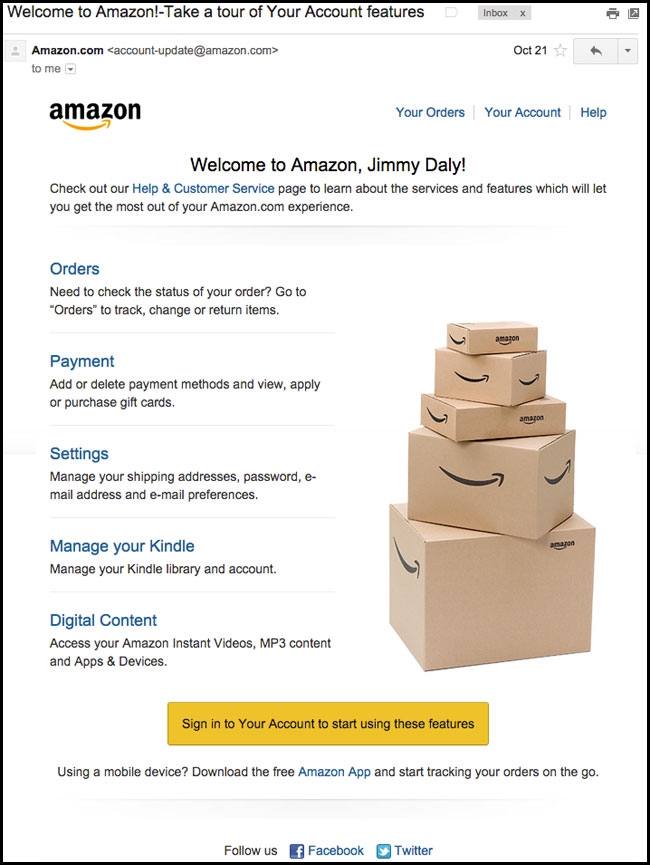
2. Emailed Receipts
Most businesses wouldn’t even think about using receipt emails for more marketing. But Amazon doesn’t ever concede an opportunity.
Look at the image of a typical receipt email from Amazon shown below. Notice how a link titled “Your Recommendations” has crept into the email. This signals that Amazon now has enough data about you. It is starting to make personalized recommendations.
Notice also that there are some social sharing links … in case you want to tell your friends about your recent purchase. The receipt also links to all the services Amazon offers along with any sale. Amazon starts building your familiarity with their systems … like how to track your order or get help.
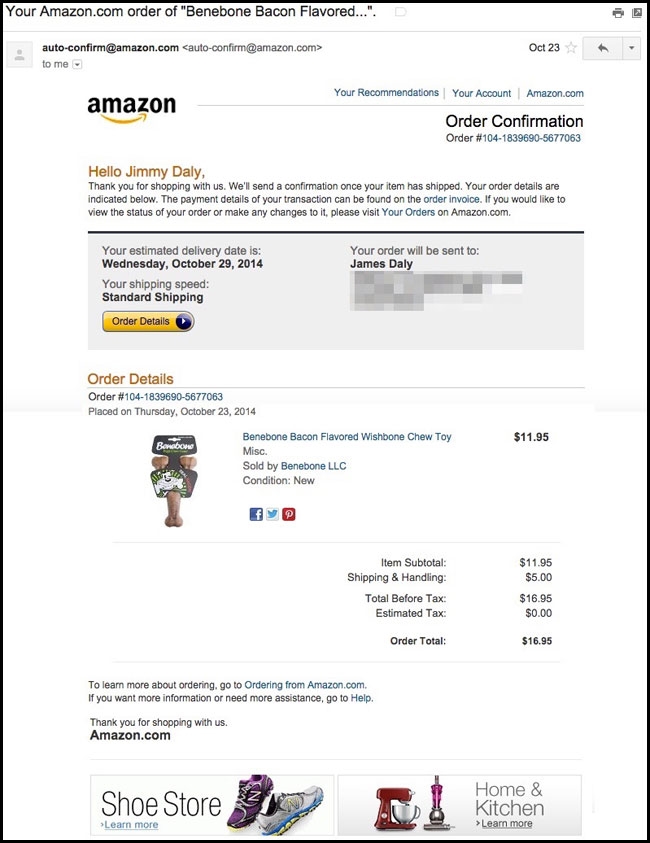
3. Shipping Confirmations
Amazon’s shipping confirmation email usually arrives after they have shipped the order. It looks innocuous, but that’s when you have to try and think about what Amazon’s strategy for this email could be. Nothing is a simple administrative email if it’s from Amazon.
Notice in the image below, that this email almost replicates the order receipt email. The only difference is that it’s shorter. But again, see all the same links are available. You are also enabled to directly “Track Your Order”.
This too is a very smart attempt to keep enhancing your familiarity with the Amazon sales process. In ecommerce there is a lot that happens at the back end. To customers unfamiliar with a business and its processes, everything “unseen” feels “unsure”. But if a business let’s you get familiar with its systems, and shows you how to get needed information from its site, you lose all fear of doing business with that business.
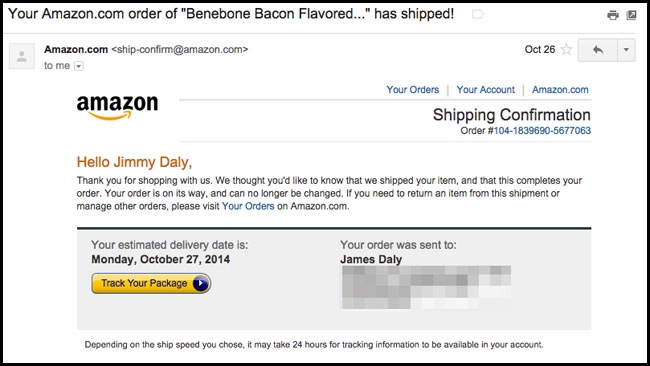
b. The Next Set Of 3 Emails From Amazon That Put “Repurchasing” Front And Center
To get you to buy more is the objective of the three kinds of emails from Amazon below.
4. Thank You Emails
You’ve bought something from Amazon … and got an order confirmation, a receipt email and a “just shipped” email. Is there room for one more email? Sure there is!
In the guise of a “thank-you” email, you receive another “get familiar with everything we have to offer” email. Notice how, step by step, you are being drawn into the depths of the Amazon repertoire of ecommerce services.
On the surface, this “thank-you email” seems like a lovely gesture, but can you see what a masterstroke it is? It introduces you to Amazon’s big value-adds. It’s no longer about small links to “My Account” or “Track Your Order”. It’s about “Amazon Prime”, “Amazon Devices”, “Subscribe & Save”, the “Amazon App” …

5. Up-sells and Cross-sells
The up-sell and cross-sell emails from Amazon will surprise you. You would expect that these emails would show you more goods related to the products you have bought. But no, you are not shown specific products – you get a link to the hot deals in the whole category.
In the mail image below see how a buyer of pet supplies is only told that there are deals on many more pet supplies. The link button leads to deals in the category of pet supplies. What could the strategy behind this piece of email content be?
With a little thinking it becomes obvious. A pet supplies buyer already knows what else he may need. He doesn’t need to reminded of things to buy. He will buy them anyway. But what may affect his decisions to buy these from Amazon are the price deals. So why waste an email with more product ideas? Price deals are what will galvanize the buyer’s decision.
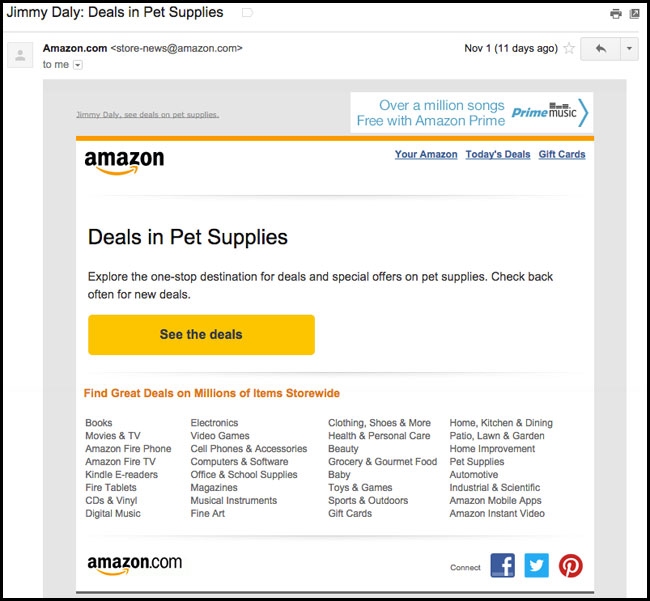
6. Review Emails
Amazon, like most ecommerce businesses, likes to collect customer ratings and testimonials. But the way it is able to do this is special.
Amazon is data-driven to the core. The company knows exactly what concerns people about any of the products it sells. See the example below. Amazon must have loads of data showing people’s concerns about non-standard shoe sizes. “Is the fit good?”, may be what most buyers ask.
If you have bought these large-fit shoes, Amazon doesn’t let you give only your own opinions. It gets your general reviews and ratings, but it also makes sure to prompt you to talk about the fit of the shoes. Your answer then directly helps another customer with the same doubts.
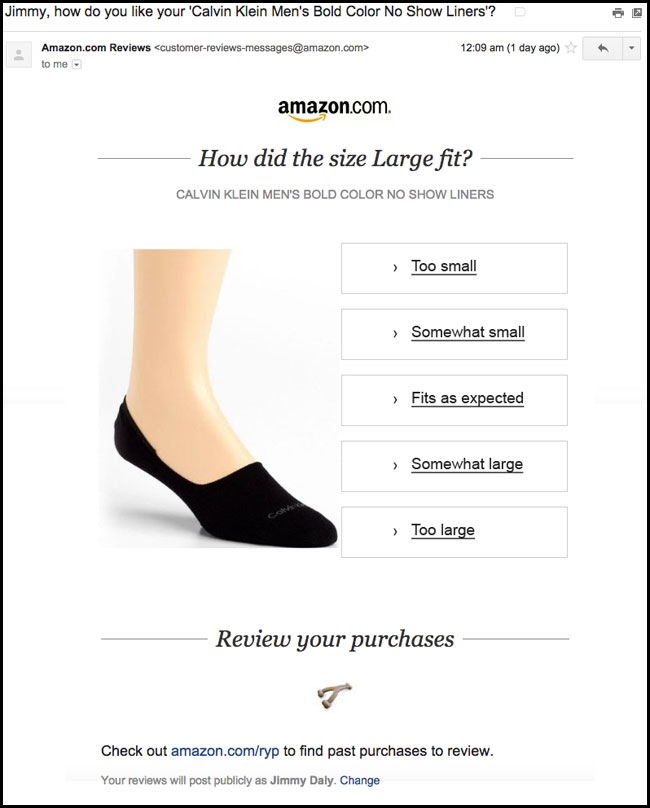
c. The Following Set Of 2 Emails From Amazon That Never Let You Out Of Their Loop
To keep you in the Amazon fold is the goal of the next two kinds of emails below. many an e-commerce business lets customers slip out of hand right here – but not Amazon.
7. Promotion Emails
As with most ecommerce, it’s a great ploy to use holidays and festive occasions to increase sales. Amazon too sends out promotional emails to highlight special days.
Notice in the example email below. It highlights only the important information. Amazon doesn’t use an inch of space “preaching to the already converted”. A person knows what they want for Black Friday. What concerns them is:
1. Will Amazon reach my purchases to me on time and not have late deliveries?
2. Are there attractive price-offs so I can buy more for my budget now?
These are exactly what this email reassures you on. For the rest, Amazon knows you will buy all you need anyway because you know what you want. If at all you want to add new stuff to buy, the price will be the decider.
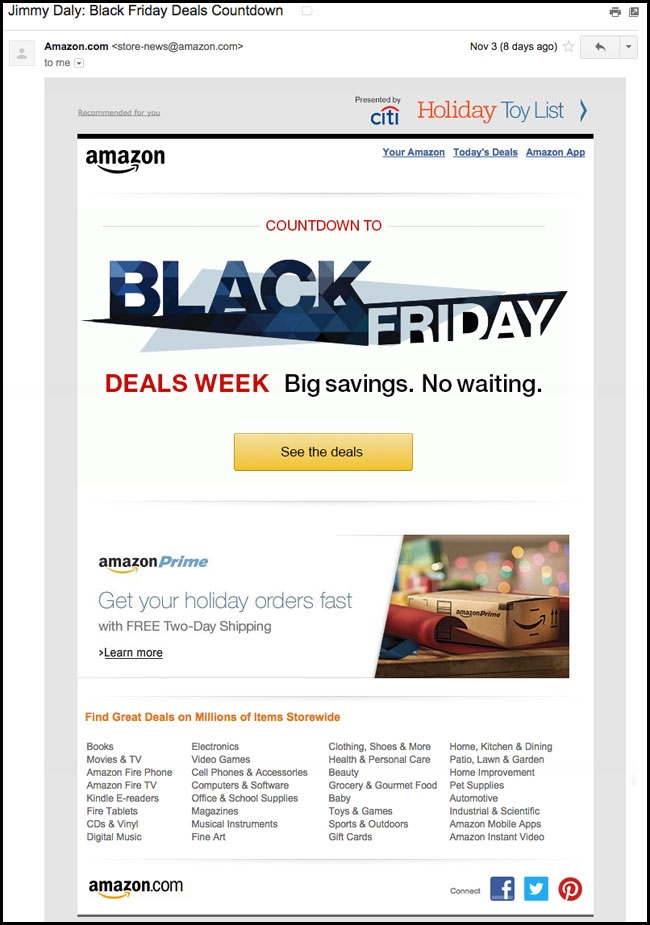
8. Browsing History FollowUps
Let’s suppose you’ve been browsing a particular category page on Amazon for a space of time. But then you leave without making a purchase. Amazon sends out an email with some suggestions, based on your previous visit.
But here’s something interesting. See the email subject – it reminds you of the item you were browsing for. You’ll also notice Amazon never pushes you to “Buy Now”. It never tries to show you that it is in haste to make you complete your browsing with a sale.
Instead, it gives you buttons or links that say “Learn More” or “Add to Wishlist.” It invites you to go further in your browsing and take the next action, which need not be a sale. That is so reassuring to someone who is not ready to buy yet, but is still holding the product he wants in mind.

3. How Amazon Proliferates Its Brand And Attracts Customers
Apart from email marketing, Amazon uses many ingenious strategies to increase its reach with greater audiences. Three very intelligent ideas are these:
a. Your Brand Store in Amazon
Amazon developed its idea of allowing brand stores inside its own site. You can set up your ecommerce store within Amazon. Look what a win-win this idea is. If you’re a small business, you can grow by gaining from Amazon’s massive goodwill and footfall. If you are a big brand, Amazon adds your brand goodwill and footfall to its own site.
Sellers can design their brand pages as they like and even show multimedia content. They can also work on their brand awareness and increase traffic to their brand pages. They can do this by using social media plug-ins that help proliferate their messages.
Look at this brand store below set inside the Amazon site. Each brand can distinguish its own pages to look unique … but they can also use Amazon’s powerful back-end engine. This helps cut the hassles of building an ecommerce site from scratch.
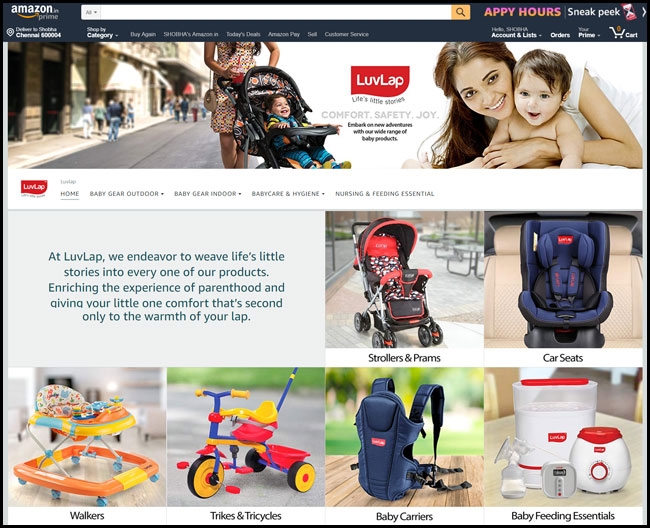
b. The Amazon Associates Affiliate Program
Amazon Associates is the world’s largest and most trusted affiliate program. Millions of sites, blogs and email newsletters worldwide are Amazon affiliates, earning commissions.
Joining the program is easy. Amazon vet your site, and then leave you to do the selling in many different ways. There are tools and help materials that Amazon provides. These include a resource center and discussion forums, as well as email and phone support.
You can choose from over a million products to advertise to your customers. You can also earn up to 12% in advertising fees in certain categories. The payment system is comprehensive and well-managed.
One more thing. If you get your visitors to click on an Amazon affiliate link on your website, you will receive a commission from any product they buy on Amazon during the next 24 hours. They don’t have to buy only the product you recommend. This can help to hugely boost your earnings.
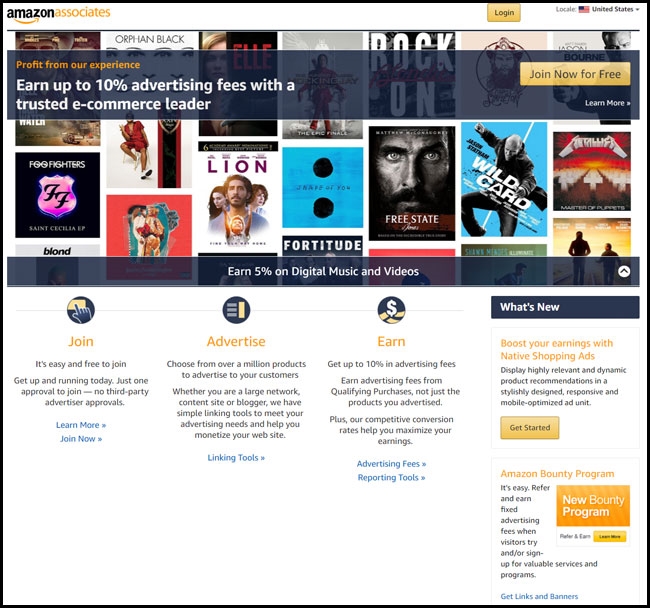
c. How Amazon Seems To Smartly Use The Social Media
There are four main social networks Amazon seems to be active on. In each channel, they have a different strategy.
1. Amazon’s Facebook Strategy
Facebook is where Amazon handles a lot of customer queries with prompt responses. It’s where complaints or doubts can be handled for you. Amazon has 28.7 million likes on Facebook, and social experts attribute this to the fact that Amazon answers every single query. Amazon also facilitates conversations between its fans making its brand a member of the larger community.
2. Amazon’s Twitter Strategy
Amazon uses Twitter mostly to post excerpts of its blog posts. It also posts events, special deals, and other happenings from its various global Amazon sites. Twitter is the “news and articles from Amazon” kind of social channel.
3. Amazon’s Instagram/Pinterest Strategy
Pinterest and Instagram for Amazon are extensions of its main online store. You could think of these as allowing window shopping at a place away from the main Amazon site. But links are provided to lead you to the Amazon site buying pages for the items shown.
4. Amazon’s new Spark social channel
Spark is a social channel proprietary to Amazon. It is similar to Instagram and Pinterest in its visual-heavy skew, but it is more dedicated to online shopping. You could say it’s a “social network for shopping”
In Summary …
- All of us in Knowledge Commerce at some stage dream of having an “estore” with Amazon’s example before us of earth-shattering success.
- The idea of earning such vast wealth from “passive incomes”, like Amazon does, is even more tempting. Have you ever wondered what exactly Amazon does in ecommerce marketing?
- Do what Amazon does. Start with a clear and simple goal. Make small changes. Test and tweak everything till it’s near-perfect.
- The best lessons from Amazon seem to come in the areas of deeply understanding the customer, relentless self-improvement and personalization of recommendations and offers.
- Email marketing is Amazon’s forte. Amazon emails are very simple yet powerful. Customers don’t even realize how they are being cajoled towards more and more purchases.
- Amazon also uses many other ingenious strategies to increase its reach with greater audiences – like “Your Brand Store in Amazon” or the “Amazon Affiliates” program.
So What Are Your Thoughts? Do Share!
This post is incomplete without your input. The community of Knowledge Commerce solopreneurs would feel galvanized to hear from you … so do share your thoughts on this topic with us, in the comments field below this post.
Business & Finance Articles on Business 2 Community
(66)
